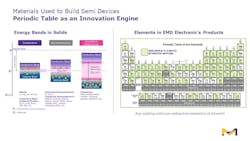Megatrends Set to Transform the Semiconductor Industry in 2025
What you’ll learn:
- What are the megatrends driving semiconductor industry growth?
- Why the semiconductor industry needs materials intelligence for next-generation chips.
- What innovations are happening at the materials level to enable chip manufacturers’ technology roadmaps?
- What role does generative AI play in speeding up materials discovery and materials intelligence?
Generative artificial intelligence (AI) is one of the major factors pushing everything from chiplet technology to software applications. It’s also improving development workflows. At the base of this technology are the materials used to build the electronics driving this revolution. This isn’t to overlook the effect of the CHIPS Act or the need for new skills, which are other challenges these days.
Looking at what’s in store this year, I talked with Ganesh Panaman, President of Intermolecular services, EMD Electronics, the Electronics business of Merck KGaA, about the megatrends driving the semiconductor industry.
What megatrends are driving the return to growth in the semiconductor industry?
Since the emergence of generative AI, we have witnessed its transformative capabilities. For the semiconductor industry, it presents both challenges and opportunities. Now, we can utilize AI and machine learning to identify and optimize smarter materials for greater efficiency. However, AI solutions require more power and storage, leading to the challenge of making chips smaller, faster, and stronger.
As chips become more sophisticated, a few atoms will determine the functionality of a whole chip. We need new materials and enhancements to current materials in use that can enable higher-performance devices (Fig. 1).
Additionally, wearable devices have become a norm in our everyday lives, with recent prominence in eyewear specifically. These new devices demand leaner solutions to support AR and VR (augmented and virtual reality) operations, which new technologies enable to run within smaller devices.
Lastly, there’s a global focus on renewable-energy sources, and sustainability is driving demand for applications such as solar panels, energy storage systems, and efficient power management devices.
The push to bring AI to the edge (for example, AR glasses, real-time processing of large amounts of data for self-driving cars) will require not just scaling according to Moore’s Law, but alternative architectures (e.g., neuromorphic computing and quantum computing) to surpass the limitations of power and memory. Given the success of generative AI, this trend will accelerate in unprecedented ways.
What role does material science, or “materials intelligence,” play as the building block of AI and high-performance computing? Why is the semiconductor industry in the "age of materials?"
Technological shifts require us to reconsider how we design materials for the next generation of chips. Alternative architectures, improved performance, and the need for high-bandwidth memory access will necessitate both traditional scaling approaches and novel materials, heterogeneous integration, advanced packaging, and device design, as well as materials co-optimization. Multi-component oxides, chalcogenides, transparent conductive oxides, 2D materials, and other multi-component alloys are becoming commonplace in the device roadmap.
To further enhance the inherent properties of semiconductor devices, there’s a growing need for co-optimization of device and materials technology at higher levels of abstraction. This marks an inflection point in materials research methodologies (Fig. 2).
Traditionally, the discovery of new materials relied on arduous, iterative, costly lab synthesis and testing processes involving semiconductor makers, tool manufacturers, and material suppliers. With AI pushing the demand for semiconductors to unprecedented levels, this model is challenged to meet the demand for rapid, co-optimized, and efficient introduction and scaling of new materials.
Materials suppliers, such as EMD Electronics, are in a prime position to lead these innovation efforts to accelerate growth while mitigating risks associated with the introduction of new materials.
Materials intelligence involves the scientific understanding and engineering of materials at the atomic and molecular levels, and the integration of digital technologies to optimize material properties, performance, and manufacturing processes.
By applying AI and machine-learning algorithms to this data, EMD Electronics can predict material behaviors under various conditions, identify optimal material compositions for specific applications, and enhance manufacturing efficiencies. This unique capability enables the production of the right material with the right quality, at the right place, and at the right time.
Materials will extend their enabling role from the front end into other innovation hotspots of the value chain, such as heterogeneous integration. We have entered an era where Moore’s Law is being challenged. The pursuit of faster, energy-efficient computing is transforming the semiconductor industry. As we shift from node-driven to a system-wide approach across the entire value chain, involving further diversification and specialization, it’s crucial that we systematically seek the next evolution in materials.
Looking ahead:
- Innovation will be more dynamic, uneven, and sporadic, with improvements distributed across the entire stack.
- Innovations at all stages will be coordinated to maximize benefits, emphasizing collaboration and effective data exchange as critical factors.
What innovations are happening to bring about miniaturization, vertical stacking, and complexity at the atomic level to enable chip manufacturers' technology roadmaps?
EMD Electronics is developing advanced materials and processes that drive the ongoing miniaturization of semiconductor devices. Innovations in extreme ultraviolet (EUV) lithography are essential for creating smaller, more densely packed transistors. The development of cutting-edge photoresists and patterning solutions facilitates precise nanoscale pattern formation, crucial for reducing device geometries.
To overcome the limitations of traditional planar scaling, vertical stacking technologies such as 3D NAND and backside power-delivery through-silicon vias have become increasingly essential. Advanced dielectric and metallization solutions ensure reliable and efficient vertical interconnections. Innovations in etch and deposition processes enable the precise construction of multi-layered structures, leading to higher memory densities and enhanced performance within a reduced footprint.
As semiconductor devices grow more complex, achieving atomic-level precision becomes increasingly vital. The materials industry is at the forefront of developing atomic layer deposition (ALD) and atomic layer etching (ALE) technologies, which provide unmatched control over material properties and thickness at the atomic scale. These techniques are crucial for fabricating ultra-thin films and interfaces with exceptional uniformity and precision, including high aspect ratio and topographically challenging features.
Additionally, advances in novel materials such as 2D materials and quantum dots are expanding the possibilities in device complexity and functionality.
Together, these innovations enable chip manufacturers to advance their technology roadmaps, achieving higher performance, greater efficiency, and new functionalities in next-generation semiconductor devices.
Where does AI, ML, and data analytics factor into this new era of material intelligence?
The global data landscape is experiencing exponential growth, presenting us with unparalleled opportunities to gain deeper insights into our production processes and materials. However, handling this vast amount of data comes with its own complexities, posing challenges that require innovative solutions. EMD Electronics uses AI to develop solutions that can run AI platforms more efficiently.
As the number of QC parameters continues to rise, it’s critical that we don’t cling to outdated data-analytics approaches from decades ago. Adapting and embracing advanced analytics methodologies is paramount to controlling the relevant parameters and preventing exponential cost increases. Our scientists and engineers use the most advanced digital tools coupled with the powerful capabilities of our Intermolecular services to advance modern technology.
The focus on co-optimization of devices and materials using advanced device testing capabilities allows us to harness the potential of AI in scientific discovery. This drives further AI advances and accelerates innovation across various fields.
By studying the interactions between different materials, processes, and device architectures, we can identify solutions that exhibit superior performance at an earlier stage. Our work in areas such as DRAM capacitor stack engineering, ALE, and neuro-inspired computing fully embraces and demonstrates this digital transformation.
Using rapidly evolving digital tools for materials modeling and discovery, we can expand the breadth and depth of our exploration space and efficiently identify new molecules and integrated solutions that drive innovation for chip manufacturers.
In addition, accelerating materials innovation requires access to, and the ability to process, extremely large amounts of data. Such processes require advanced computing platforms such as quantum computing and neuromorphic computing to identify novel chemistries and materials.
This will also require high throughput and combinatorial capabilities with the ability to rapidly prototype and test devices, such as what we have at our Intermolecular facility. Our work with PsiQuantum is an excellent example of how we are enabling massive improvements in quantum computing by pioneering new materials.
The key component in scaling quantum computers is the single photon detector (SPD). This requires thin films with superconductivity that are accessible only at very low temperatures (<10K), which makes system scalability challenging.
At Intermolecular, we managed to identify promising bulk superconductors, scale to thin film, and optimize the stack. The result demonstrated record SPD performance, and we are continuing to innovate to demonstrate dramatic improvement in critical temperature for this Gen 2 material.
Ganesh Panaman is the President of Intermolecular services at EMD Electronics, the Electronics business of Merck KGaA, Darmstadt, Germany. In his current role, Ganesh is dedicated to accelerating lab to fab, securing first-mover advantages on disruptive technologies, and actively engaging with the dynamic startup ecosystem in the Bay Area.
With over two decades of experience, Ganesh has held pivotal roles across various high-tech industries, showcasing a strong aptitude for technology development and customer engagement. Previously, as Director of Customer Programs at Intermolecular Inc., Ganesh led key initiatives in DRAM, NVM, and quantum computing, forging long-term partnerships and ensuring the success of these programs, and consistently delivering innovative solutions to meet diverse customer needs. In addition, Ganesh has significant expertise in R&D and HVM scale-up from his tenure at First Solar, Solyndra, AMAT, and Apple.
He holds master’s degrees in Material Science & Nano Engineering from University of Albany and in Electrical Engineering from the University of Texas at Arlington.
About the Author
William G. Wong
Senior Content Director - Electronic Design and Microwaves & RF
I am Editor of Electronic Design focusing on embedded, software, and systems. As Senior Content Director, I also manage Microwaves & RF and I work with a great team of editors to provide engineers, programmers, developers and technical managers with interesting and useful articles and videos on a regular basis. Check out our free newsletters to see the latest content.
You can send press releases for new products for possible coverage on the website. I am also interested in receiving contributed articles for publishing on our website. Use our template and send to me along with a signed release form.
Check out my blog, AltEmbedded on Electronic Design, as well as his latest articles on this site that are listed below.
You can visit my social media via these links:
- AltEmbedded on Electronic Design
- Bill Wong on Facebook
- @AltEmbedded on Twitter
- Bill Wong on LinkedIn
I earned a Bachelor of Electrical Engineering at the Georgia Institute of Technology and a Masters in Computer Science from Rutgers University. I still do a bit of programming using everything from C and C++ to Rust and Ada/SPARK. I do a bit of PHP programming for Drupal websites. I have posted a few Drupal modules.
I still get a hand on software and electronic hardware. Some of this can be found on our Kit Close-Up video series. You can also see me on many of our TechXchange Talk videos. I am interested in a range of projects from robotics to artificial intelligence.




